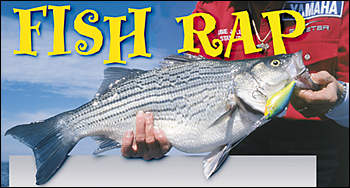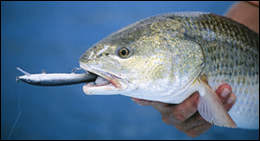
From humble beginnings in a Finnish fishing boat, Lauri Rapala's lure-making tradition lives on in a world-class way.
By Paul A. Cañada
I was introduced to both fishing and the Normark Corp. in 1967. While replenishing our supply of hooks and lead split-shot, my best friend Kelvin and I spied our first Rapala at a Colorado Springs department store.
Compared to the other lures sitting on the scarcely stocked shelf, the silver and black, neatly packaged plug looked like a rare diamond.

Here's a new twist for you: The Rapala Suspending Husky Jerk. The mullet-imitating plug perfoms best when worked in either the surf or waist-deep bay flats. The Husky Jerk maintains position when stopped - the exact time, in fact, when this brand-new bait is most likely to get hammered by maurading redfish, trout and other coastal gamefish. Furthermore, it's just as effective for sweetwater species like largemouth bass and striped bass.
|
Although I thought it an unrealistic request, I asked for the lure for my 12th birthday. My dad - an Air Force staff sergeant - was away in Turkey, so money was very hard to come by for our family.
Still, I selfishly had high hopes.
On my birthday, Kelvin and his dad - the two who introduced me to fishing - remembered my silver and black plug. Regretfully, I later traded that first Rapala away to my younger - often much wiser - brother for what I thought at the time was a much-needed baseball.
Still, that first silver and black Rapala holds a special place in my angling heart. And today, a half-dozen of the floating models - handcrafted and tank-tested just like my first Rapala 30 years ago - hold a prominent place in my tackle box.
The amazing Finn
The story of my first Rapala plug begins in Finland, more than 6 decades ago. The lightweight plug with the enticing action was conceived by commercial fisherman Lauri Rapala. The impoverished Finn worked hard at fishing in order to provide for his family during a period dominated by war and economic depression.
Lauri Rapala caught perch and pike on a baited trotline he trailed behind the soutouvene - a traditional Finnish fishing boat - that he rowed. Rapala's eldest son, Risto, tells how his dad rowed as much as 30 miles a day. The long hours spent on the water gave Rapala many opportunities to observe nature.
While watching schools of minnows swimming in the clear water below his small boat, Rapala noticed how predators would target a single fish out of an entire school of baitfish. The Finn realized that there must have been a subtle difference in how an injured or diseased minnow looked or swam.
Eventually, Rapala identified the difference as the slightly off-center wobble of a struggling baitfish. Realizing that a lure imitating this action might help him catch more fish to make more money for his family, Rapala picked up a shoemaker's knife, sandpaper and file.
In 1936, Rapala carved his first successful lure out of cork. He then glued tinfoil from a neighbor's cheese packets and chocolate bars to create the lure's outer surface. And because he was unable to secure any lacquer, he melted discarded photographic negatives to form a protective coating over the lure. The completed product - with black back, gold flanks and white belly - accurately imitated an injured Lake Paijanne minnow.
A Family Affair
Shortly after creating the new lure, Lauri Rapala joined the Finnish Army in defending his homeland against invading Russians and Germans.
After the war, word about Rapala's fishing success and new lure quickly spread throughout Finland. The demand for the rare, handcrafted lure grew and the family took on a new business. Before long, the immediate family, in-laws, cousins and the residents of Vaaksy were hard at work meeting the tremendous demand.
Throughout the stepped-up production, Lauri Rapala demanded that above all else, accuracy must be maintained. The elder Rapala insisted that every lure made be tank-tested to assure that it maintained the life-like wobble.
The Rapala family was now producing up to 1,000 hand-crafted, tank-tested lures a year. It didn't take long for the reputation of the legendary Rapala lure to spill westward to America.
Vihtori Tommola, a friend of the Rapala family and a Finnish immigrant to America, returned from vacations in Finland with lures for other Finnish immigrants. Additional lures made their way to the U.S. via American athletes returning from the 1952 Summer Olympics held in Helsinki, Finland.
The lures' popularity quickly grew, especially with Finns living in those fringe areas along the Canadian-American border.
continued
page 1 / page 2
| 




